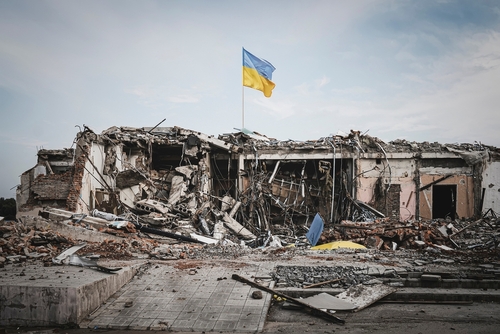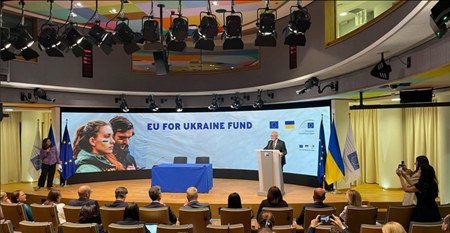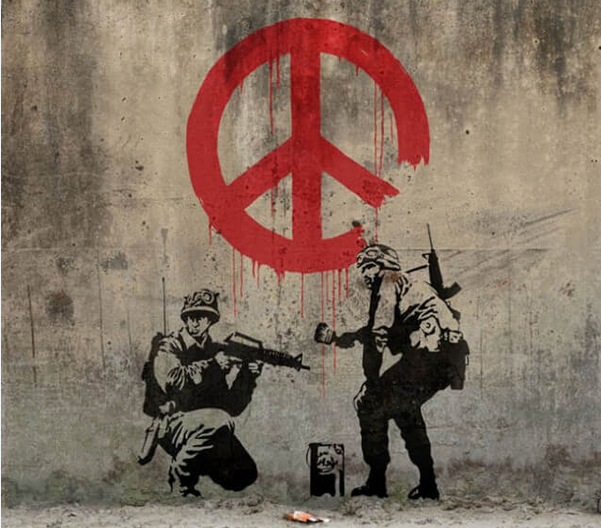


The West and Europe, Between Values and Geopolitics
10 October 2023
Unpacking Organised Crime
29 August 2024Matthias Thiemann, Centre for European Studies and Comparative Politics
Russia’s attack on Ukraine on February 24, 2022, came largely as a surprise to the world community. Following a few weeks of wrangled diplomacy seeking to halt the descent into carnal chaos, Ukraine entered into the abyss of warring hostilities with Russia, which would take with it the entire set-up of the European political economic order as it evolved in the 2000s. No longer would cheap Russian gas fuel the German economy, the growth engine of the EU and its strongest member, nor would extensive financial investments from private companies into Russia continue, being replaced by forced nationalisations of Western companies in Russia and the retreat of most, if not all firms from that country.
In this situation of dismal surprise, the unity and resolve of the EU and its member states has been tested and, to the surprise of many, if not most observers (1)Russia’s invasion of Ukraine is remaking Europe, The Washington Post, Kelemen and McNamara 2022, the EU actually held together a rather coherent set of foreign policies, allowing a series of sanctions on the Russian economy. While not being lethal, these sanctions still managed to extract a toll on the latter, its most important elements, the shutdown of most gas and fuel exports from Russia to the EU, exempting only its most dependent members. Furthermore, the EU and its member states, in conjunction with its allies in NATO extended military and financial support to Ukraine and opened its borders to Ukrainian refugees. In 2023, the EU is hosting more than 3.5 million Ukrainian war refugees and has overall pledged or extended more than 76 billion Euros in macro-financial and refugee assistance as well as military aid (2)Factsheet: EU solidarity with Ukraine.
A Rapid and Ambitious Response
As such, the reaction of the EU and its members to the war in its neighbouring country was surprisingly swift and its financial and political engagement of unprecedented proportion. In this process, the European Commission itself became a central coordinating actor, using new instruments such as the ‘European Peace Facility’ (3)‘Facility’ is the technical word to describe funding programs in the EU.to deliver and channel e.g. military aid to Ukraine. In one of its boldest moves, the Commission has been pushing for the initiation of an EU accession process for Ukraine, which is supposed to integrate Ukraine in the EU on an accelerated track. All these efforts show the commitment of the EU to include Ukraine in its geopolitical proximity, with a perspective to full integration within the next decade. This commitment raises the question of how the EU seeks to facilitate the reconstruction of that country, if and when the hostilities end(4)Any such events need to secure a lasting end to hostilities, without which private and public investment will appear largely pointless. This will require a peace settlement, the outlines of which currently can only be guessed at.. This engagement for reconstruction imposes itself not only as an act of solidarity, but is as much an act of necessity to stabilise Ukraine, which without such support would face the prospect of a deep economic and legitimacy crisis, with all its potential negative spillover effects. As such, aid for reconstruction, much like the case of the Marshall plan for the US, lies as much in the interest of the sending as of the receiving country.
Such reconstruction efforts, estimated at 400 billion Euros by the World Bank in spring 2023, need to focus as much on the reestablishment of an energy infrastructure destroyed by the war as on the sustainable modernization of an industrial sector which currently is highly carbon intensive. This reconstruction of Ukraine, a country rich in mineral and agricultural resources, with a highly educated population and a strong industrial base, as much as it is promising in terms of potential return, runs high risks both due to the endemic corruption which Ukraine is known for as well as the potential for a new round of hostilities, once the present war is over. The way that the EU seeks to counter these difficulties and to engage in the process of investment is through a public-private partnership, which involves the use of public funds to (re-)build a well functioning administrative apparatus and to derisk private investments through public guarantees, a technique widely used in the last decade to engage public investment within the EU, which primarily involves the field of European Development Banking, with the European Investment Bank (EIB) at its helm (5)The Ukraine recovery conference held in London in June 2023 is the best example of this trend. It assembled large development banks, such as the World Bank, the IMF and the Ukrainian government officials in order to lay out how such schemes for co-investment of the private sector with public funds could be organised, which was to be accompanied by an extensive process of liberalising reforms in Ukraine. This conference followed in the wake of an announcement that BlackRock and JPMorgan Chase were to help Ukraine to set up a Ukrainian development bank, which was to be funded by foreign donors, among which the European Commission and its development bank, the EIB to attract private funds for reconstruction. see BlackRock and JPMorgan help set up Ukraine reconstruction bank, Financial Times, June 19th 2022..
In this vein, the EIB has been at the forefront of the Commission’s attempt to engage in the reconstruction efforts in Ukraine(6)Individual member states have also begun to set out schemes for reconstruction and aid, as have individual cities through partnerships (s. e.g. the recent partnership of Berlin and Kiev, formed in September 2023. For space reasons, this essay focuses its analytical focus on efforts at the EU level.(7)Mertens, D., M. Thiemann and P. Volberding (eds). 2021. The Reinvention of Development Banking in the European Union – Industrial Policy in the Single Market and the Emergence of a Field. Oxford: Oxford University Press ; Mertens, D., M. Thiemann (2019). Building a hidden investment state? The European Investment Bank, national development banks and European economic governance, Journal of European Public Policy, 26:1, 23–43..
Within the year 2022, the EIB used its existing business relations with Ukraine and, based on an EU guarantee disbursed 1.7 bn Euros in loans to help finance emergency repairs to the country’s infrastructure ravaged by Russian bombing. At the same time, the EIB mobilised to secure further funding for reconstruction efforts, proposing to refurbish a de-risking scheme developed during Covid for the engagement with Ukrainian reconstruction. Based on the existing legal arrangements for the latter document, the EIB proposed a hundred billion Euro facility, the EU-Ukraine Gateway Trust Fund (E-U GTF), which would seek to have an initial €20 billion in contributions from EU countries and the EU budget in the form of grants, loans and guarantees(8)EIB to raise €100 billion to help rebuild Ukraine, EurActiv, July 2022 . Rebranded as the EU4Ukraine facility, the EIB installed said facility by end of March 2023, in the process, however, acknowledging a much-reduced size, foreshadowing a dangerous trend of high ambitions, followed up by rather minimal follow-through, as the EU 4 Ukraine facility is a scaled-down version of the initially much more ambitious plan.
Financial Resources Below Promises
Rather than the 20 bn Euros aimed at, a mere 400 million Euros had been paid in by member states by the end of July 2023, 2% of the initially envisioned sum (EU Member States pledge over €400 million to the EIB’s Fund supporting Ukraine). While a few small countries (Croatia, Greece, Cyprus, Denmark, Estonia) in the EU have been pledging additional support, it is clear that even reaching 1 billion Euro paid-in capital will be hardly achievable. These financing means have been complemented by an EU guarantee enabling the EIB to provide an additional €100 million of new loans to Ukraine agreed in June 2023.(9)New EU contribution for EIB’s Ukraine support package to enable new lending of €100 million, EIB, June 2023.. In a typical move, the Commission, rather than devoting new money earmarked this guarantee from the EUR26bn guarantee provided in May 2022 by the Commission to the EIB for EIB external action as part of the Commission’s European Fund for Sustainable Investment Plus (EFSD+)(10)The Fund will focus on municipal infrastructure (schools and hospitals, transport networks, water and wastewater treatment facilities), digital and cybersecurity capability, and improved access to finance for Ukrainian entrepreneurs.. After all, these efforts at mobilising funds enabled the EIB at the London Conference for the reconstruction of Ukraine on June 21st/22nd 2023 to announce the signature of a memorandum of understanding between the European Investment Bank and Ukraine, ‘to prepare and facilitate new investments worth €840 million in critical infrastructure projects to ensure recovery even despite the difficult conditions’ (EIB and Ukraine strengthen cooperation to support country’s reconstruction projects with €840 million)).The actual devoted financial means for reconstruction efforts by the EU and the EIB thus remain far behind initial ambitions.
Ukraine Recovery Conference URC in Lugano, Switzerland, 3 July 2022. Crédits : [EPA-EFE/PASCAL LAUENER
The plan, to be set up by the Ukrainian government and civil society, is to plan investments from 2024 to 2027. The structure of the new Ukraine Facility is to be composed of three pillars. The first pillar, making up 78% of the financing effort is to finance direct EU support to the Ukraine Plan through grants and loans. The second pillar is to be composed of a de-risking mechanism available to investors through International Financial Institutions, such as the EIB to scale up investments and crowd in new investors Support to the Ukrainian private sector.
The current Facility project envisions an 8.9 bn Euro guarantee for said effort, about half of what the current InvestEU plan foresees for the EU as a whole. The third pillar foresees the financing of technical assistance to the Government (EU acquis, structural reforms) devoted to capacity building of the authorities at national, regional and local level. Member States, third countries, international organisations, international financial institutions or other donors will be able to provide additional contributions to the Facility.
An Issue of Credibility and Stability
Remarkable with respect to the plan is the large percentage of non-repayable funds, making up a total of up to 39 bn Euros; with only maximum 9 billion Euros in the form of an EU guarantee devoted to de-risking instruments. In addition, the devotion of several billion Euros of funds to the building of capacity represents an investment of the EU into the future of Ukraine as a potential member of the EU.
This new facility, like all funding efforts of the EU, is dependent upon member state approval, who have proclaimed their willingness to fund the EU efforts to support Ukraine, at the same time that they have bemoaned other unexpected additional financing requests by the EU, hence demanding EU level budget cuts ( (EU’s €86bn budget battle casts shadow over Ukraine funding, Financial Times, 29th of August 2023).
The question of how to secure the financing hence looms large over the reconstruction efforts in Ukraine. If the EU wants to finance these efforts, without substantially cutting back on its other activities, it will have to find additional revenues, for which efforts are under way. In this vein, in a recent meeting in Portugal, Ministries for European affairs from Germany, France as well as Portugal expressed their support for the generation of additional fees and revenues for the EU in order to be able to marshall the funds to invest in the European reconstruction efforts of Ukraine (France, Germany, Portugal pitch EU levies and Ukraine ‘Marshall plan’, Politico Playbook Report, 31 août 2023). . If these efforts bear fruit, the reconstruction efforts for Ukraine might bring the empowerment of the centralised EU level, further pushing the EU along the path of state formation (12)Kelemen, R. D., & McNamara, K. R. (2022). State-building and the European Union: Markets, War, and Europe’s Uneven Political Development. Comparative Political Studies, 55(6), 963–991.. If they do not, and reconstruction efforts founder due to lack of financial means, the EU will have to face a lasting reputation of hollow promises, not to mention the deception and potential backlash it will create in Ukraine.
Matthias Thiemann is an Associate Professor in European Public Policy at the Centre for European Studies and Comparative Politics. He earned his Phd from Columbia University in 2012. He is currently investigating financial regulation pre and post-crises, and the use of development banking as a public policy tool. He demonstrates the establishment of an increasingly important and openly assumed "investor state" in Europe, based on these stakeholders and the use of the European budget.
Notes
| ↑1 | Russia’s invasion of Ukraine is remaking Europe, The Washington Post, Kelemen and McNamara 2022 |
|---|---|
| ↑2 | Factsheet: EU solidarity with Ukraine |
| ↑3 | ‘Facility’ is the technical word to describe funding programs in the EU. |
| ↑4 | Any such events need to secure a lasting end to hostilities, without which private and public investment will appear largely pointless. This will require a peace settlement, the outlines of which currently can only be guessed at. |
| ↑5 | The Ukraine recovery conference held in London in June 2023 is the best example of this trend. It assembled large development banks, such as the World Bank, the IMF and the Ukrainian government officials in order to lay out how such schemes for co-investment of the private sector with public funds could be organised, which was to be accompanied by an extensive process of liberalising reforms in Ukraine. This conference followed in the wake of an announcement that BlackRock and JPMorgan Chase were to help Ukraine to set up a Ukrainian development bank, which was to be funded by foreign donors, among which the European Commission and its development bank, the EIB to attract private funds for reconstruction. see BlackRock and JPMorgan help set up Ukraine reconstruction bank, Financial Times, June 19th 2022. |
| ↑6 | Individual member states have also begun to set out schemes for reconstruction and aid, as have individual cities through partnerships (s. e.g. the recent partnership of Berlin and Kiev, formed in September 2023. For space reasons, this essay focuses its analytical focus on efforts at the EU level. |
| ↑7 | Mertens, D., M. Thiemann and P. Volberding (eds). 2021. The Reinvention of Development Banking in the European Union – Industrial Policy in the Single Market and the Emergence of a Field. Oxford: Oxford University Press ; Mertens, D., M. Thiemann (2019). Building a hidden investment state? The European Investment Bank, national development banks and European economic governance, Journal of European Public Policy, 26:1, 23–43. |
| ↑8 | EIB to raise €100 billion to help rebuild Ukraine, EurActiv, July 2022 |
| ↑9 | New EU contribution for EIB’s Ukraine support package to enable new lending of €100 million, EIB, June 2023. |
| ↑10 | The Fund will focus on municipal infrastructure (schools and hospitals, transport networks, water and wastewater treatment facilities), digital and cybersecurity capability, and improved access to finance for Ukrainian entrepreneurs. |
| ↑11 | Proposal For a Regulation of The European Parliament and of The Council On Establishing the Ukraine Facility, European Commission, Brussels, 20.6.202. |
| ↑12 | Kelemen, R. D., & McNamara, K. R. (2022). State-building and the European Union: Markets, War, and Europe’s Uneven Political Development. Comparative Political Studies, 55(6), 963–991. |





